| Pages:
1
..
8
9
10
11 |
nux vomica
Hazard to Others
  
Posts: 267
Registered: 18-7-2013
Member Is Offline
Mood: No Mood
|
|
Quote: Originally posted by lysander  | Wait, you both feed the pulse back into the capacitor block (as shown on nux's correction to my first schematic)? And you don't isolate your
voltmeter from it?
I guess that could work because the bridge wire is sort of a fast-blow fuse. But only sort of: I would have guessed that the ionized airgap would
conduct a good amount of the remaining voltage in the capacitor bank as a surge even after the bridgewire has blown. Of course, I haven't actually
done it and you two have plenty of successful shots, so if you haven't fried anything downstream of the bridgewire then I guess it works!
|
Its all about the cap + - potential as well as the caps low internal resistance the fireing of the circuit balances the potential in the caps while
the gap is still conducting .
The voltage divider gives a high resistance so only a small current can flow so the voltmeter is well isolated .
[Edited on 14-3-2016 by nux vomica]
|
|
|
lysander
Hazard to Self
 
Posts: 69
Registered: 12-7-2015
Member Is Offline
Mood: No Mood
|
|
@nux, I can't tell from the Sketchup and photo how you're actually wired. Are you doing two pairs of caps in series, as in my diagram? Or are you
going for the full series 5200V?
Here's an updated schematic. If this is right then it looks like the trickiest part is tuning the trigatron. @nux: in the video where you were testing your trigger something flashed each time but I couldn't tell what it was. Were you just dumping the pulse back
into the capacitor bank?
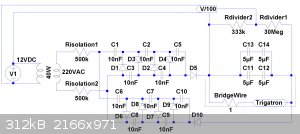
|
|
|
nux vomica
Hazard to Others
  
Posts: 267
Registered: 18-7-2013
Member Is Offline
Mood: No Mood
|
|
Quote: Originally posted by lysander  | @nux, I can't tell from the Sketchup and photo how you're actually wired. Are you doing two pairs of caps in series, as in my diagram? Or are you
going for the full series 5200V?
Here's an updated schematic. If this is right then it looks like the trickiest part is tuning the trigatron. @nux: in the video where you were testing your trigger something flashed each time but I couldn't tell what it was. Were you just dumping the pulse back
into the capacitor bank?
|
Full series 5200v 1.25 UF. in the video I was letting the charging circuit run and just firing the spark gap with the piezio, the flash is the spark
in the gap as it travels to the other side of the capacitor.
|
|
|
PHILOU Zrealone
International Hazard
    
Posts: 2893
Registered: 20-5-2002
Location: Brussel
Member Is Offline
Mood: Bis-diazo-dinitro-hydroquinonic
|
|
Unless I'm wrong detonation is a fast explosion...
Before putting others on the line read carrefully what they wrote!
*********************************************
Then I fill the ampoule with whatever I want:
For ignition:
-Black powder
-KClO3/S/C/CaCO3 black powder
For flash or detonation:
-Ni(N2H4)3(NO3)2 --> this flashes-bang
-Ni(N2H4)3(NO3)2 / Silver acetylide nitrato complex (2/1 by weight) --> this detonates > 5 km/s
-Silver acetylide nitrato complex --> this detonates > 3 km/s
The last two are true detonators because the ampoule can hold a detonating material up to 1.2 cm long and 0.4 cm large.
I insert the powder with a tiny paper cone and slight vibrations...I also hit smoothly the ampoule sothat the powder self confide to a higher density.
When everything is inserted, I check for the integrity of the resistance of the filament, I press a little more the powder from above and insert even
more powder.
--> I try to get as much into the ampoule at the max density.
I recheck for the integrity of the resistance of the filament and finally I put a tiny drop of concentrated nitrocellulose/aceton on top to seal the
ampoule and leave to dry. The NC cap cover is active material and can transmit the detonation wave to a secondary material...
Those devices can be inserted as such for ingitors or detonators in sensitive mixes or in larger/longer copper pipe detonators with
a secondary (avoiding contact of the wires with the pipe of course --> use of glue to fix the glass to the pipe).
*********************************************
Here is a picture of a EBW and of my light-bulb version...you are very strong if you can tell me a difference...
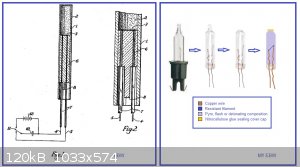
PH Z (PHILOU Zrealone)
"Physic is all what never works; Chemistry is all what stinks and explodes!"-"Life that deadly disease, sexually transmitted."(W.Allen)
|
|
|
lysander
Hazard to Self
 
Posts: 69
Registered: 12-7-2015
Member Is Offline
Mood: No Mood
|
|
Quote: Originally posted by nux vomica  |
In the video I was letting the charging circuit run and just firing the spark gap with the piezio, the flash is the spark in the gap as it travels to
the other side of the capacitor. |
Why is the flash visible? It looks like you have the gap inside an opaque insulated tube.
|
|
|
Microtek
National Hazard
   
Posts: 827
Registered: 23-9-2002
Member Is Offline
Mood: No Mood
|
|
Philou:
The difference is that in a true EBW, the bridge wire takes the place of primary explosive: The electrical discharge dumps so much energy into the
wire, so suddenly that it vaporizes and then even more into the ionized plasma so it explodes and causes the secondary base charge to detonate.
So an EBW is an example of an NPED, but much more reliable than the ones relying on DDT of something like specially treated PETN.
|
|
|
Herr Haber
International Hazard
    
Posts: 1236
Registered: 29-1-2016
Member Is Offline
Mood: No Mood
|
|
Errrm? Isnt that disappointing? I was planning on trying NHN because it looked like a promising primary.
I'm surprised it doesnt detonate. Any idea why?
Ah, here I can offer a massive improvement I believe. Go to your closest "cooking supplies" store and find the bits they put in the "cones" that are
used to make meringue or writing on top of cakes. You'll find many shapes (we only care for round of course) and many diameters. If you dont
understand what I'm talking about I can send you a picture.
You wont bother with miniature paper funnels that dont keep their shape and always have some composition adhering to the sides. Better still, if you
are working with a static sensitive primary, they're made of metal ! From there, you can weld them to wire if you dont like having them in your hand
or even ground them if you feel the need 
|
|
|
nux vomica
Hazard to Others
  
Posts: 267
Registered: 18-7-2013
Member Is Offline
Mood: No Mood
|
|
Why is the flash visible? It looks like you have the gap inside an opaque insulated tube.
Yes its a plastic rod drilled out so the spark electrodes are inside i also have the piezo spark electrode tapped into the plastic rod to
insulate it from the spark gap electrodes , you dont want any chance of the electrodes conducting until you are ready.
|
|
|
PHILOU Zrealone
International Hazard
    
Posts: 2893
Registered: 20-5-2002
Location: Brussel
Member Is Offline
Mood: Bis-diazo-dinitro-hydroquinonic
|
|
Quote: Originally posted by Microtek  | Philou:
The difference is that in a true EBW, the bridge wire takes the place of primary explosive: The electrical discharge dumps so much energy into the
wire, so suddenly that it vaporizes and then even more into the ionized plasma so it explodes and causes the secondary base charge to detonate.
So an EBW is an example of an NPED, but much more reliable than the ones relying on DDT of something like specially treated PETN.
|
Thank you Microtek,
I did forgot that the metal is vapourized by the electric pulse and that it is an electric arc and the resulting shockwave that initiate a secondary
in close contact...just like a Al/CuO nanothermite would do with plasma Cu gas...
Maybe with this Al/CuO nano mix would it enter the category of NPED?
Anyway my device works with much lower current ;-) but it is as effective if you overdrive it and vapourize the filament creating an electric arc :-°
... just a little shorter delay before detonation.
PH Z (PHILOU Zrealone)
"Physic is all what never works; Chemistry is all what stinks and explodes!"-"Life that deadly disease, sexually transmitted."(W.Allen)
|
|
|
PHILOU Zrealone
International Hazard
    
Posts: 2893
Registered: 20-5-2002
Location: Brussel
Member Is Offline
Mood: Bis-diazo-dinitro-hydroquinonic
|
|
Quote: Originally posted by Herr Haber  |
Errrm? Isnt that disappointing? I was planning on trying NHN because it looked like a promising primary.
I'm surprised it doesnt detonate. Any idea why?
Ah, here I can offer a massive improvement I believe. Go to your closest "cooking supplies" store and find the bits they put in the "cones" that are
used to make meringue or writing on top of cakes. You'll find many shapes (we only care for round of course) and many diameters. If you dont
understand what I'm talking about I can send you a picture.
You wont bother with miniature paper funnels that dont keep their shape and always have some composition adhering to the sides. Better still, if you
are working with a static sensitive primary, they're made of metal ! From there, you can weld them to wire if you dont like having them in your hand
or even ground them if you feel the need  |
NHN or Ni(N2H4)3(NO3)2 is not very reliable as a detonating stuf for tiny detonators on its own...you need confinement and larger quantities for the
D2D to occure.
This may be circumvented by the admixture of silver acetylide nitrato complex (SANC/SADS) what is compatible with NHN.
I use 2/1 mix by weight of both ultrafine compounds; then the NHN benefits from the ultrasensitivity of SADS and reliability of D2D in minute amount
and the SADS benefits from the higher energy output and VOD of the NHN --> kind of complementary mix.
You may also use SADS pellet as initial detonating stuff and NHN as secondary detonating stuff prior to the "secondary" (here ternary charge).
Thank you for the kitchen cone idea...I never had troubles with paper...no adherence of the powder onto it...depends certainly of the smoothness of
paper you choose (sand paper  ? - just kidding ? - just kidding  ) )
You can also use the end of a plastic drink straw to insert completely the straw with 1cm of loose powder at the end into the bulb sothat the powder
falls into the bulb without loosing a grain of initiator outside; then you refill the end of the straw and repeat until bulb completely filled.
PH Z (PHILOU Zrealone)
"Physic is all what never works; Chemistry is all what stinks and explodes!"-"Life that deadly disease, sexually transmitted."(W.Allen)
|
|
|
lysander
Hazard to Self
 
Posts: 69
Registered: 12-7-2015
Member Is Offline
Mood: No Mood
|
|
Quote: Originally posted by nux vomica  |
Why is the flash visible? It looks like you have the gap inside an opaque insulated tube.
Yes its a plastic rod drilled out so the spark electrodes are inside i also have the piezo spark electrode tapped into the plastic rod to
insulate it from the spark gap electrodes , you dont want any chance of the electrodes conducting until you are ready. |
So is the flash visible because the plastic is actually translucent?
And the piezo electrode does discharge its spark into one of the gap electrodes, right? I.e., the electrode tip is exposed to the airgap
inside the rod, and the only "insulation" is the air gap?
|
|
|
Aurium
Harmless

Posts: 46
Registered: 4-10-2015
Member Is Offline
Mood: Energetic
|
|
I imagine that a SGD of mine could also be piezo triggered.
By using 3 electrodes, cap +, cap -, and a third piezo trigger in the middle.
This is a bit more complex than just a spark gap but it may be worth the engineering to have instant det on command rather than having to wait for the
caps to charge.
|
|
|
Hennig Brand
International Hazard
    
Posts: 1284
Registered: 7-6-2009
Member Is Offline
Mood: No Mood
|
|
The spark gap is normally used to ignite (detonate?) a primary explosive very fast (with almost no delay), but in some cases it can obviously be used
as a detonator for secondary explosives as well and in this case is another example of just how sensitive ETN can be to some stimuli. The exploding
bridge wire, EBW, is a different animal entirely from a resistive element electrical heater/igniter, or even the spark gap detonator. It may be hard
to believe at first glance but given the extremely small amount of time involved that tiny bit of gold, platinum, or copper wire is actually a very
effective energy storage device because of its mass, heat capacity/sensible heats, latent heats: heat of fusion, heat of vaporization, (also heat of
plasma?) and also electrical resistance and how that resistance changes with temperature. Its mass also aids the transfer of energy (I think) once the
inertia of the wire is overcome and the extremely rapid explosive expansion and shockwave takes place. A great deal of energy is stored in the wire,
with the correct application of energy, which is released explosively and can very effectively and reliably initiate many secondary explosives.
[Edited on 15-3-2016 by Hennig Brand]
"A risk-free world is a very dull world, one from which we are apt to learn little of consequence." -Geerat Vermeij
|
|
|
nux vomica
Hazard to Others
  
Posts: 267
Registered: 18-7-2013
Member Is Offline
Mood: No Mood
|
|
Quote: Originally posted by lysander  | Quote: Originally posted by nux vomica  |
Why is the flash visible? It looks like you have the gap inside an opaque insulated tube.
Yes its a plastic rod drilled out so the spark electrodes are inside i also have the piezo spark electrode tapped into the plastic rod to
insulate it from the spark gap electrodes , you dont want any chance of the electrodes conducting until you are ready. |
So is the flash visible because the plastic is actually translucent?
And the piezo electrode does discharge its spark into one of the gap electrodes, right? I.e., the electrode tip is exposed to the airgap
inside the rod, and the only "insulation" is the air gap? |
Yep its only a standard 3 electrode spark gap switch with airgap between the two main electrodes the piezo electrode is close enough to fire the
gap but far enough away so the electrodes wont bridge across it and fire .
The plastic is white but the spark is so bright it still is visable on the outside
|
|
|
Hennig Brand
International Hazard
    
Posts: 1284
Registered: 7-6-2009
Member Is Offline
Mood: No Mood
|
|
I have a couple other things to add to my last post. The spark gap detonator is interesting and useful in some applications, but I have to pick on it
a little.
With enough power (edit: energy) delivered quickly enough to the gap a spark gap could probably be used to detonate anything an EBW could, but I think
the EBW is much more efficient, reliable and safer. Everything else being equal (fireset/capacitor(s), wire type and length, explosive to be
initiated, etc) an EBW should be able to provide a more energetic, more intense impact/shock making it more effective as an initiator. I have not
tested a spark gap detonator, but it seems that variables effecting performance and reliability are more difficult to control. I can say from
experience that with even modest care EBWs can be made very reliable.
[Edited on 21-3-2016 by Hennig Brand]
"A risk-free world is a very dull world, one from which we are apt to learn little of consequence." -Geerat Vermeij
|
|
|
Aurium
Harmless

Posts: 46
Registered: 4-10-2015
Member Is Offline
Mood: Energetic
|
|
The novel interesting feature about a SGD is that the coupled capacitor can be made at least 10x smaller than with an EBW.
I'v had repetitive success with ETN at just 0.1uF (5kV) and some meters of wiring, which is much less than the 1uF~2uF capacitor rule of thumb for an
EBW. So I can have a smaller cap and equal cable length, or an equal cap and larger cable lengths.
In terms of firing energy the SGD is much cheaper. ~10x less cap energy is needed.
Oh, and no dealing with hair-thin wires and soldering, its of very simple construction.
But you are right Hennig, I found that the ETN must be very low density for the SGD to work, and I haven't tested it with any other explosive other
than ETN.
I'd be great-full if you could provide some free readings on the physics of EBWs.
My idea of an EBW is that the goal is just to super heat the wire, and the expansion and explosion initiates the explosive, I never imagined an energy
accumulation mechanism in the thin wire.
IMO its like the EBW is a cannon ball and the SGD is a sniper bullet.
With the EBW one has to super-heat the whole thin wire to a plasma and from then on, involving a few mg of copper to be heated.
In a SGD one only has to heat a superthin air path at first.
Air is ~1000x less dense than metal, so its allot less material to be plasmafied. ~1000x less material + the same energy dumped means x1000 hotter
temperatures and x1000 faster expansion, but with x0.001 the mass involved in an EBW. (say in the ug range)
Which is best is a matter of further experimentation.
[Edited on 21-3-2016 by Aurium]
|
|
|
Hennig Brand
International Hazard
    
Posts: 1284
Registered: 7-6-2009
Member Is Offline
Mood: No Mood
|
|
The spark gap is used for very little commercially or by the military from everything I have read, with the most notable exception being the very
famous RPG-7 system which uses it, fired by a piezoelectric impact fuse crushed on impact, to instantaneously ignite a primary explosive at the rear
of the shaped charge. This should indicate some things about a spark gaps suitability for most purposes.
Yeah, EBWs generally use a 1uF capacitor bank or larger even in their systems but they often fire many shots simultaneously and from much more than a
few meters away in cable length (the capacitance used is by no means the minimum in most cases with commercial systems). The bridgewire in an EBW is a
very easily controlled, well defined, energy dissipation medium/element whereas what is between the spark gap is more difficult to control. If in fact
EBWs take more power to fire this would likely be seen as a good thing from a military and commercial perspective (the main reason to go with slappers
over EBWs from what I understand is that they require much more power again to fire making them even less likely to be involved in an accident).
Can discuss more later maybe. No time at the moment.
[Edited on 22-3-2016 by Hennig Brand]
"A risk-free world is a very dull world, one from which we are apt to learn little of consequence." -Geerat Vermeij
|
|
|
yobbo I
Harmless

Posts: 8
Registered: 20-3-2016
Member Is Offline
Mood: No Mood
|
|
There is an attached .rar on page one of this thread around 13 / 4/ 15
[Edited on 21-3-2016 by yobbo I]
|
|
|
Rosco Bodine
Banned
Posts: 6370
Registered: 29-9-2004
Member Is Offline
Mood: analytical
|
|
IIRC the spark gap from a Wimhurst static generator and Leyden jar "accumulator" is the historically original "first embodiment of a practical
detonator" and was used to detonate nitroglycerine before later attempts to replace the SGD scheme using detonating caps ultimately settling for a
mercury fulminate blasting cap as the simpler replacement for the original practical means which was the SGD. On the old google explosives newsgroup
it was reported that a ball of cotton soaked in NG in the base of a fired .22 rimfire could be reliably detonated by a spark across the cut end of a
piece of coaxial cable butted against the NG soaked cotton and crimped to secure, fired directly one shot pulse discharge by an automotive ignition
coil.....kaboom, presto high order detonation.
I think I have seen this concept mentioned in literature possibly a biography on Sobrero or Nobel but am not finding any search hits about it, and I
have not tested the idea which appears to be obscure information. But ETN is about as near to NG in a solid form as will be found and definitely a
bit less stable than NG so it makes sense a SGD would or should work for ETN and function simply by thermal shock alone augmented by any local shock
wave from expanding air in the "pop" of an arc. If it is pure thermal shock then an intense IR laser pulse should do the same to cook off the HE high
order.
[Edited on 3/21/2016 by Rosco Bodine]
|
|
|
Aurium
Harmless

Posts: 46
Registered: 4-10-2015
Member Is Offline
Mood: Energetic
|
|
I love the random pieces of explosive tech trivia you guys know ahahah. Ya ol'times kaboomer.
I bet it's all about that local shockwave caused by the expanding plasma because:
1- A lower energy spark will not detonate the ETN. All plasmas are several thousands kelvin which is more that enough to overcome any activation
energy.
Maybe it takes a minimum shockwave intensity to cause a detonation.
2- The ETN does not detonate when exposed to a very hot flame, it just decomposes. It only dets when wrapped in aluminum foil, behavior that I
can only
attribute to a catalyzing effect by the Al.
A SGD is just as safe as having the ETN sitting in a plastic tube.
If one is concerned about static detonating accidentally one simply link the two input wires and unlink them moments before use.
Also it takes a heck of static jolt to cause a detonation or any activation.
It won't happen in a billion years.
Still, I understand that it is a tiny bit less safe than an EBW, hence unsuitable for use in nuclear detonators. And one can never be too safe about
nukes.
Will have to keep on testing them, maybe with different energetics.
If a SGD takes x10 less energy to fire ETN, perhaps it also takes x10 less energy to fire RDX or TNT or other true secondaries.
If not well yea it makes little sense to use it commercially, those guys aren't worried about the price or size of the capacitors.
|
|
|
yobbo I
Harmless

Posts: 8
Registered: 20-3-2016
Member Is Offline
Mood: No Mood
|
|
If you want small you go for slapper detonators. It's slappers in all nukes, most misiles etc
|
|
|
Hennig Brand
International Hazard
    
Posts: 1284
Registered: 7-6-2009
Member Is Offline
Mood: No Mood
|
|
Wrapping in aluminum foil confines the ETN, which prevents heat from dissipating as quickly and pressure to rise more allowing the temperature to rise
higher which in turn results in faster combustion which again raises the temperature even faster and higher. There may be some sort of catalytic
effect as well, I don't know. It doesn't take much thermal shock to push ETN to detonation. I was getting good pops from little bits of loose ETN by
simply touching it with the end of a hot soldering iron, with no confinement at all!
Temperature tells us about the energy level of a unit of something. A Bic lighter can apparently reach temperatures as high as 2000C, but good luck
using it to solder a copper pipe with lead solder. Way more than enough temperature, but because the amount of heat/energy produced is so low it can't
raise the temperature of the copper pipe enough. For thermal shock there needs to be a reasonable amount of energy, but more importantly it has to be
delivered extremely quickly.
The higher the "energy density", and the faster the energy can be delivered, the more shock, the more intense impact, which can be produce and the
more ability the energy donor will have at initiating a secondary explosive. The wire in the EBW is a type of energy concentrator, or accumulator,
which stores and then releases the energy extremely rapidly and from a very small volume (highly concentrated/focused energy). As much energy as
possible in as small a volume as possible in as small a time as possible is what we are after, well enough to be a reliable initiator anyway.
[Edited on 24-3-2016 by Hennig Brand]
"A risk-free world is a very dull world, one from which we are apt to learn little of consequence." -Geerat Vermeij
|
|
|
nux vomica
Hazard to Others
  
Posts: 267
Registered: 18-7-2013
Member Is Offline
Mood: No Mood
|
|
Just had a successful test of a ebw detonator that uses a 1206 smt resistor unstead of a fine bridgewire, the reasoning is that you break the wire
frequently while building the detonator, and a resistor wont be as delicate and should still be able to set off etn.
The resistance of the resistor is 2 ohms and it is recessed into the plastic holder to insulate the electrodes from the metal 9 volt battery caseing.
I used 1 grm of etn in the caseing and charged up to 4000 volts and had it fireing through 25 meters of coax , the s/s target is 2mm thick.
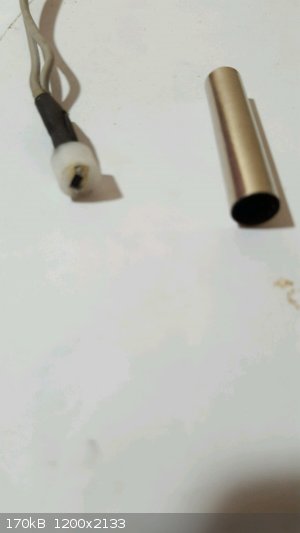 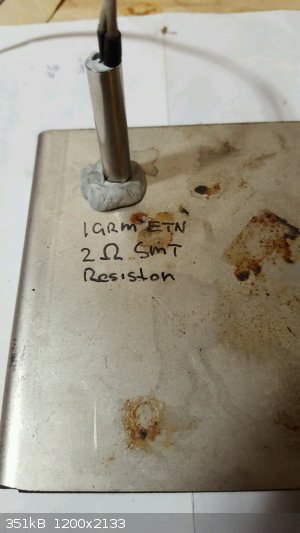 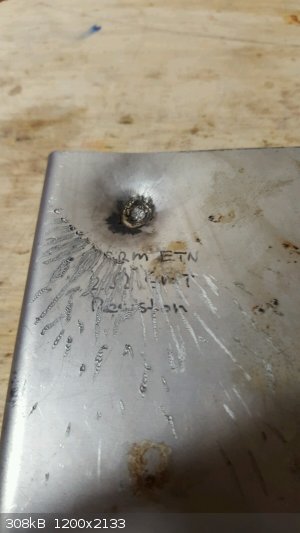
|
|
|
PHILOU Zrealone
International Hazard
    
Posts: 2893
Registered: 20-5-2002
Location: Brussel
Member Is Offline
Mood: Bis-diazo-dinitro-hydroquinonic
|
|
Quote: Originally posted by nux vomica  | Just had a successful test of a ebw detonator that uses a 1206 smt resistor unstead of a fine bridgewire, the reasoning is that you break the wire
frequently while building the detonator, and a resistor wont be as delicate and should still be able to set off etn.
The resistance of the resistor is 2 ohms and it is recessed into the plastic holder to insulate the electrodes from the metal 9 volt battery caseing.
I used 1 grm of etn in the caseing and charged up to 4000 volts and had it fireing through 25 meters of coax , the s/s target is 2mm thick.
|
1g of detonating ETN should have made a neat/clean hole (of the diameter of the pipe holding the ETN) through your 2 mm plate...
I think it didn't detonate but simply deflagrated.
PH Z (PHILOU Zrealone)
"Physic is all what never works; Chemistry is all what stinks and explodes!"-"Life that deadly disease, sexually transmitted."(W.Allen)
|
|
|
Aurium
Harmless

Posts: 46
Registered: 4-10-2015
Member Is Offline
Mood: Energetic
|
|
Quote: Originally posted by PHILOU Zrealone  |
1g of detonating ETN should have made a neat/clean hole (of the diameter of the pipe holding the ETN) through your 2 mm plate...
I think it didn't detonate but simply deflagrated. |
I agree. Even 0.1g could do more damage than shown.
What capacitance are you using?
Using a resistor makes sense over a thin wire. Get more juice out of the capacitor during the first milisecond.
Still, why did you choose to go with an SMD resistor instead of a regular one?
Those are allot of work to solder.
|
|
|
| Pages:
1
..
8
9
10
11 |